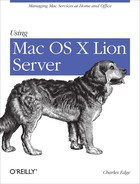A single Mac OS X Server configured with good hardware can handle around 300 connections from users. That’s on the high end. On the low end, a mini server should be able to handle between 15 and 25 concurrent users, depending on which type of files are being accessed and the protocols used to access those files. As we’ve shown in this chapter, OS X Server comes with a number of features—from managing permissions to controlling shares and backing up data—that make OS X Server a great file server for practically any platform.
As you can tell from how much time we spent looking at it, one of the most critical aspects of centralizing data is backing up that data. Time Machine makes for a great tool to get your data backed up regularly to disks. Time Machine also leverages the file services in OS X Server to take that backup and extend it to users on the network in the form of Time Machine Server. This new feature marks a great new feature in OS X Server, and best of all, can be pushed to users using Profiles, as we’ll show in Chapter 8.
File services are one of the most common requirements for any server, and a critical aspect to many a workflow. Now that we’ve looked at enabling our first services in OS X Server (AFP, SMB, WebDAV, and Time Machine Server), let’s turn our attention to sharing a different type of data. In Chapter 4, we will move on to shared contacts, calendars and instant messaging, often referred to as “groupware.”
